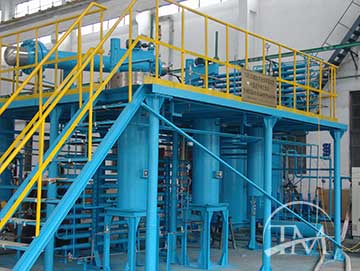Purification refers to the purification of the mixture to remove its impurities and obtain the main substance in the mixture. The purified impurities do not need to consider their chemical composition and physical state. There are many separation methods for mixtures, but according to their separation nature, they can be divided into two categories:
1. Chemical Separation
2. Physical Separation Method
The following methods for chemical separation and purification of mixtures are summarized as follows:
Principles of Separation and Purification
1. The introduced reagents generally react only with impurities.
2. Subsequent reagents should remove excessive pre-added reagents.
3. New substances should not be introduced.
4. The substances produced by the reaction between impurities and reagents are easily separated from the purified substances.
5. The process is simple, the phenomenon is obvious and the purity is high.
6. Converting impurities into required substances as far as possible;
7. Reasonable order of reagents should be considered when removing various impurities.
8. When encountering water-soluble gases, the phenomenon of backdraft should be prevented.
Conceptual distinction
Clean:
Separation of solids with high density and insolubility from liquids, separation of sand and water;
Filtration:
Separate insoluble solids from liquids and purify edible water.
Dissolution and filtration:
Separation of two solids, one soluble in a solvent, the other insoluble, separation of salt and sand;
Centrifugal separation method:
Separate insoluble solids from liquids and cement and water.
Crystallization:
The dissolved solute is separated from the solution and the salt is extracted from the sea water.
Separation:
Separate two immiscible liquids and separate oil and water.
Extraction:
The iodine in aqueous solution was extracted by dissolving and separating a component in the mixture with appropriate solvent.
Distillation:
Solvents and non-volatile solutes were separated from the solution and pure water was obtained from seawater.
Fractionation:
Separation of two liquids with different boiling points, separation of oxygen and nitrogen in liquid air, refining of petroleum;
Sublimation:
Separation of two solids, only one of which can be sublimated to separate iodine and sand;
Adsorbent:
Removal of gaseous or solid impurities in the mixture, and removal of colored impurities in yellow sugar by activated carbon.
Chemical methods commonly used for separation and purification
1. Heating method
When the mixture is mixed with a substance with poor thermal stability, it can be heated directly to decompose and separate the substance with poor thermal stability. For example, mixing NH4Cl in NaCl and Na2CO3 with NaHCO3 can remove impurities by direct heating.
2. Precipitation
Adding a reagent to the mixture to separate one of them in the form of precipitation. When using this method, we must pay attention not to introduce new impurities. When various reagents are used to precipitate different particles in the solution step by step, attention should be paid to removing the excessive part of the reagent after adding, and no new impurities are introduced into the reagent at last. For example, Na2SO4 mixed in NaCl can be removed by adding appropriate amount of BaCl2 solution.
3. Acid-base method
The purified substance does not react with acid and base, but impurities can react with acid and base, using acid and base as impurity removal reagent. For example, CaCO 3 in SiO 2 is removed by hydrochloric acid and aluminium powder in iron powder is removed by sodium hydroxide solution.
4. Redox Reaction Method
If reductive impurities are mixed in the mixture, appropriate oxidizers can be added to oxidize the mixture to be purified. If chlorine water is dripped into FeCl_3 solution mixed with FeCl_2 to remove the impurities of FeCl_2, as well as if oxidizing impurities are mixed in the mixture, appropriate reductant can be added to reduce it to the purified substance. If excessive iron powder is added into FeCl2 solution mixed with FeCl3, the impurities of FeCl3 can be removed.
5. Conversion method
If the separation can not be achieved at one time, it needs to be transformed into other substances for separation, and then the transformed substances can be restored to the original substances. When separating Fe3+ and Al3+, excessive NaOH solution can be added to form Fe(OH)3 and NaAlO 2. After filtration, hydrochloric acid can be added to regenerate Fe3+ and Al3+. In the process of transformation, the loss of separated substances should be minimized, and the transformed substances should be easily recovered to the original substances.
6. Adjusting pH
A method of precipitation and separation of a component in solution by adding reagents to adjust the pH of the solution. Generally, it is regulated by adding corresponding insoluble or micro-soluble substances. For example, FeCl3 impurities are contained in CuCl2 solution. Because FeCl3 is hydrolyzed and the solution is acidic, Fe3+ can be precipitated by adjusting pH. For this reason, CuO, Cu OH, CuCO 3 or Cu2 (OH) 2CO 3 can be added to the solution.
7. Electrolysis
Using the principle of electrolysis to separate and purify substances, such as, electrolytic refining of copper, that is, using crude copper as anode, refined copper as cathode, using solution containing copper ions as electrolyte, under the action of direct current, impurity metals in crude copper which are more active than copper lose electrons, and only copper ions are electronically precipitated in the cathode, thus purifying copper.
